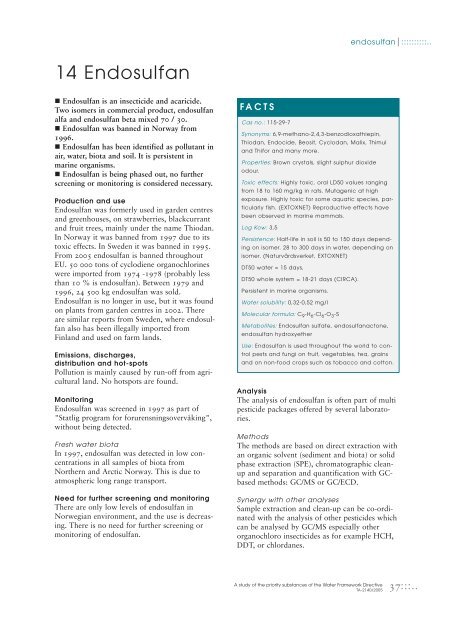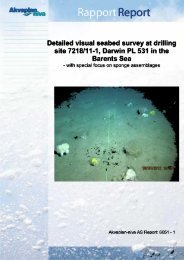A study of the priority substances of the Water Framework Directive ...
A study of the priority substances of the Water Framework Directive ...
A study of the priority substances of the Water Framework Directive ...
You also want an ePaper? Increase the reach of your titles
YUMPU automatically turns print PDFs into web optimized ePapers that Google loves.
14 Endosulfan<br />
� Endosulfan is an insecticide and acaricide.<br />
Two isomers in commercial product, endosulfan<br />
alfa and endosulfan beta mixed 70 / 30.<br />
� Endosulfan was banned in Norway from<br />
1996.<br />
� Endosulfan has been identified as pollutant in<br />
air, water, biota and soil. It is persistent in<br />
marine organisms.<br />
� Endosulfan is being phased out, no fur<strong>the</strong>r<br />
screening or monitoring is considered necessary.<br />
Production and use<br />
Endosulfan was formerly used in garden centres<br />
and greenhouses, on strawberries, blackcurrant<br />
and fruit trees, mainly under <strong>the</strong> name Thiodan.<br />
In Norway it was banned from 1997 due to its<br />
toxic effects. In Sweden it was banned in 1995.<br />
From 2005 endosulfan is banned throughout<br />
EU. 50 000 tons <strong>of</strong> cyclodiene organochlorines<br />
were imported from 1974 -1978 (probably less<br />
than 10 % is endosulfan). Between 1979 and<br />
1996, 24 500 kg endosulfan was sold.<br />
Endosulfan is no longer in use, but it was found<br />
on plants from garden centres in 2002. There<br />
are similar reports from Sweden, where endosulfan<br />
also has been illegally imported from<br />
Finland and used on farm lands.<br />
Emissions, discharges,<br />
distribution and hot-spots<br />
Pollution is mainly caused by run-<strong>of</strong>f from agricultural<br />
land. No hotspots are found.<br />
Monitoring<br />
Endosulfan was screened in 1997 as part <strong>of</strong><br />
"Statlig program for forurensningsovervåking",<br />
without being detected.<br />
Fresh water biota<br />
In 1997, endosulfan was detected in low concentrations<br />
in all samples <strong>of</strong> biota from<br />
Nor<strong>the</strong>rn and Arctic Norway. This is due to<br />
atmospheric long range transport.<br />
Need for fur<strong>the</strong>r screening and monitoring<br />
There are only low levels <strong>of</strong> endosulfan in<br />
Norwegian environment, and <strong>the</strong> use is decreasing.<br />
There is no need for fur<strong>the</strong>r screening or<br />
monitoring <strong>of</strong> endosulfan.<br />
FACTS<br />
Cas no.: 115-29-7<br />
Synonyms: 6,9-methano-2,4,3-benzodioxathiepin,<br />
Thiodan, Endocide, Beosit, Cyclodan, Malix, Thimul<br />
and Thifor and many more.<br />
Properties: Brown crystals, slight sulphur dioxide<br />
odour.<br />
endosulfan ::::::::::..<br />
Toxic effects: Highly toxic, oral LD50 values ranging<br />
from 18 to 160 mg/kg in rats. Mutagenic at high<br />
exposure. Highly toxic for some aquatic species, particularly<br />
fish. (EXTOXNET) Reproductive effects have<br />
been observed in marine mammals.<br />
Log Kow: 3,5<br />
Persistence: Half-life in soil is 50 to 150 days depending<br />
on isomer. 28 to 300 days in water, depending on<br />
isomer. (Naturvårdsverket, EXTOXNET)<br />
DT50 water = 15 days,<br />
DT50 whole system = 18-21 days (CIRCA).<br />
Persistent in marine organisms.<br />
<strong>Water</strong> solubility: 0,32-0,52 mg/l<br />
Molecular formula: C 9 -H 6 -Cl 6 -O 3 -S<br />
Metabolites: Endosulfan sulfate, endosulfanactone,<br />
endosulfan hydroxye<strong>the</strong>r<br />
Use: Endosulfan is used throughout <strong>the</strong> world to control<br />
pests and fungi on fruit, vegetables, tea, grains<br />
and on non-food crops such as tobacco and cotton.<br />
Analysis<br />
The analysis <strong>of</strong> endosulfan is <strong>of</strong>ten part <strong>of</strong> multi<br />
pesticide packages <strong>of</strong>fered by several laboratories.<br />
Methods<br />
The methods are based on direct extraction with<br />
an organic solvent (sediment and biota) or solid<br />
phase extraction (SPE), chromatographic cleanup<br />
and separation and quantification with GCbased<br />
methods: GC/MS or GC/ECD.<br />
Synergy with o<strong>the</strong>r analyses<br />
Sample extraction and clean-up can be co-ordinated<br />
with <strong>the</strong> analysis <strong>of</strong> o<strong>the</strong>r pesticides which<br />
can be analysed by GC/MS especially o<strong>the</strong>r<br />
organochloro insecticides as for example HCH,<br />
DDT, or chlordanes.<br />
A <strong>study</strong> <strong>of</strong> <strong>the</strong> <strong>priority</strong> <strong>substances</strong> <strong>of</strong> <strong>the</strong> <strong>Water</strong> <strong>Framework</strong> <strong>Directive</strong><br />
TA-2140/2005<br />
37:::..

















